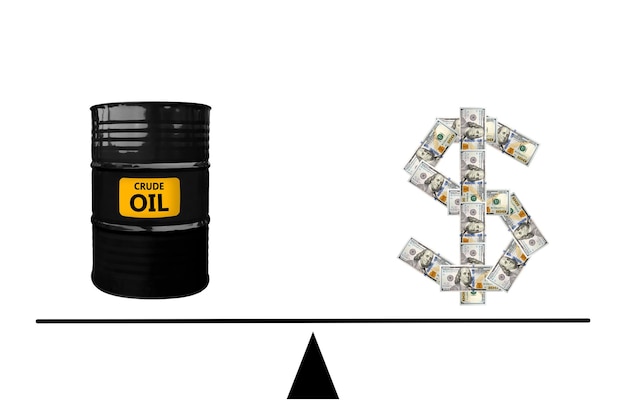US Dollar’s Fluctuations: Consequences on International Trade

The US dollar’s fluctuating value significantly impacts international trade by altering the competitiveness of US exports, influencing import prices, and affecting the financial stability of countries holding dollar-denominated debt.
The value of the US dollar is a cornerstone of the global economy, and its variations can send ripples across international trade. Understanding the **potential consequences of the US dollar’s fluctuating value on international trade** is crucial for businesses, policymakers, and investors alike.
Understanding the US Dollar’s Influence on Global Commerce
The US dollar’s role as the world’s reserve currency gives it considerable sway over the global financial landscape. Its fluctuations can significantly affect trade balances, investment flows, and economic stability worldwide. Therefore, a thorough understanding of these effects is critical for navigating the complexities of international trade.
The Dollar as a Reserve Currency
Because the dollar is widely held by central banks and used in international transactions, its stability is paramount. Its perceived safety makes it a haven during economic turmoil.
How Fluctuations Impact Trade
A stronger dollar can make US exports more expensive, potentially reducing demand. Conversely, a weaker dollar can boost exports but also increase the cost of imports.
- Export Competitiveness: A strong dollar reduces the competitiveness of US goods abroad.
- Import Costs: A weaker dollar increases the cost of imported goods for US consumers and businesses.
- Trade Balance: Currency fluctuations can significantly impact a country’s trade surplus or deficit.
In conclusion, the US dollar’s standing as the primary reserve currency means its value directly affects import and export dynamics globally, influencing economic policies of nations worldwide.

Effects on US Exports and Imports
The strength of the dollar plays a pivotal role in shaping the dynamics of US exports and imports. A strong dollar can hinder export competitiveness, while a weaker dollar can make imports more expensive, affecting businesses and consumers alike.
Impact on Exports
A strong dollar makes US products more expensive for foreign buyers. This can lead to decreased demand and reduced export volumes.
Impact on Imports
Conversely, a weaker dollar makes imports more expensive for US consumers and businesses. This can lead to higher inflation as import costs rise.
- Reduced Export Revenue: US companies may see reduced revenue if the dollar is strong.
- Increased Import Prices: Consumers face higher prices for imported goods when the dollar is weak.
- Shift in Trade Balance: A weaker dollar can help improve the trade balance by boosting exports and reducing imports.
In summary, changes in the US dollar’s value impact export revenue and import prices, potentially leading to substantial shifts in the trade balance and affecting the economic health of US businesses and consumers.
Consequences for Emerging Markets
Emerging markets often face significant challenges due to fluctuations in the US dollar. These countries typically have substantial dollar-denominated debts, making them particularly vulnerable to changes in the dollar’s value.
Debt Burden
A stronger dollar increases the burden of dollar-denominated debts for emerging markets. This can strain their economies and potentially lead to debt crises.
Capital Flows
Dollar fluctuations can influence capital flows to and from emerging markets. A stronger dollar may lead to capital flight, while a weaker dollar may attract investment.
- Increased Debt Repayments: Emerging markets need more of their local currency to repay dollar debts when the dollar is strong.
- Investment Volatility: Fluctuations can cause sharp changes in investment, destabilizing emerging economies.
- Currency DevaluationPressures: A strengthening dollar can lead to devaluation pressures on emerging market currencies.
In conclusion, fluctuations in the value of the US dollar can greatly impact emerging markets, influencing debt burdens, capital flow, and the stability of their currencies, leading to potential economic challenges.

Impact on Commodity Prices
Commodity prices, which are often denominated in US dollars, are significantly influenced by fluctuations in the dollar’s value. These fluctuations can impact both producers and consumers of commodities worldwide.
Commodity Exports
A stronger dollar can make commodities more expensive for buyers using other currencies. This can reduce demand and lower prices.
Commodity Imports
Conversely, a weaker dollar can make commodities cheaper for foreign buyers, potentially increasing demand and raising prices.
- Price Volatility: Commodity prices experience greater volatility due to dollar fluctuations.
- Impact on Producers: Producers may see reduced revenue if the dollar is strong, affecting profitability.
- Consumer Costs: Consumers may face higher prices for commodities when the dollar is weak.
In brief, fluctuations in the US dollar can affect commodity prices worldwide, influencing demand, revenue for producers, and costs for consumers, which can cause market instability.
Monetary Policy Responses
Central banks often respond to fluctuations in the US dollar through monetary policy adjustments. These responses aim to stabilize their economies and mitigate the negative effects of currency volatility.
Interest Rate Adjustments
Central banks may adjust interest rates to influence capital flows and stabilize their currencies. Higher interest rates can attract foreign investment, while lower rates can stimulate domestic growth.
Currency Interventions
Some central banks may intervene in currency markets to directly influence exchange rates. This can involve buying or selling US dollars to stabilize their own currencies.
- Attracting Investment: Higher interest rates can make a country more attractive to foreign investors, strengthening its currency.
- Stabilizing Currency Values: Interventions can reduce volatility and stabilize exchange rates.
- Managing Inflation: Monetary policy can help manage inflation caused by currency fluctuations.
In conclusion, central banks utilize monetary policies, such as interest rate adjustments and currency interventions, in response to US dollar fluctuations to stabilize their economies and manage inflation.
Strategies for Businesses
Businesses engaged in international trade can employ various strategies to mitigate the risks associated with US dollar fluctuations. These strategies include hedging, diversifying markets, and adjusting pricing strategies.
Hedging Techniques
Hedging involves using financial instruments to offset potential losses from currency fluctuations. This can include forward contracts, options, and other derivatives.
Market Diversification
Diversifying markets can reduce reliance on a single currency or region. This can help businesses weather currency fluctuations more effectively.
- Risk Mitigation: Hedging reduces risks associated with currency volatility.
- Reduced Dependency: Diversification reduces a company’s reliance on a single market.
- Pricing Flexibility: Adjusting prices can maintain competitiveness despite currency changes.
In short, businesses mitigate risks from US dollar fluctuations by using hedging, market diversification and adjusting pricing, which are all crucial for maintaining competitiveness and managing revenue during currency instability.
| Key Topics | Brief Description |
|---|---|
| 📈 Trade Balance | Dollar strength impacts US exports and imports significantly. |
| 🌍 Emerging Markets | Debt burdens increase with a stronger dollar. |
| 💲 Commodity Prices | Dollar value affects commodity demand and pricing. |
| 🛡️ Business Strategies | Hedging and diversification help mitigate risks. |
Frequently Asked Questions
A strong US dollar makes US exports more expensive and less competitive in the global market, while imports become cheaper for US consumers and businesses.
A weaker dollar can ease the debt burden for emerging markets with dollar-denominated debts, as it requires less of their local currency to repay these debts.
Central banks might adjust interest rates or intervene in currency markets by buying or selling US dollars to stabilize their currencies and manage inflation.
Businesses can use hedging techniques, diversify their markets to reduce reliance on a single currency, and adjust their pricing strategies to remain competitive despite currency changes.
A stronger dollar makes commodities more expensive for buyers using other currencies, while a weaker dollar makes them cheaper, thus influencing global demand and supply dynamics.
Conclusion
In conclusion, understanding the nuances of the US dollar’s influence on international trade is vital for stakeholders worldwide. Monitoring currency fluctuations and implementing responsive strategies can help navigate the complexities and potential challenges posed by these dynamics.





